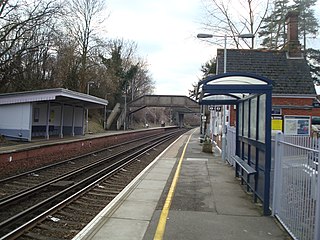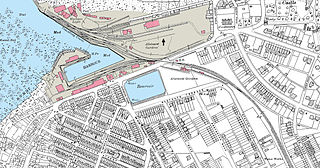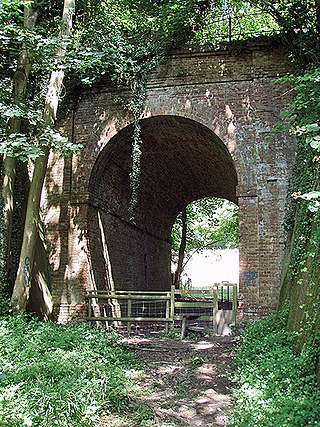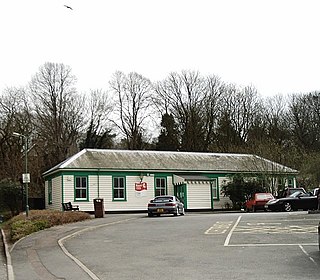
Canterbury West railway station is a Grade II listed railway station, and the busier of the two stations in Canterbury in Kent, England. The station as well as all services are operated by Southeastern with both main line and high speed trains serving the station.

Maidstone East is one of three railway stations in the town of Maidstone, in Kent, England, but currently the only one with a regular all-day direct service to London. The station is on the Maidstone line, 39 miles 76 chains (64.3 km) from ‹See TfM›London Victoria, and is served by trains operated by Southeastern.

Ashford International railway station is a National Rail station in the town of Ashford, Kent, England. It connects several railway lines, including High Speed 1 and the South Eastern Main Line. Services are operated by Southeastern and Southern.

The Hastings line is a secondary railway line in Kent and East Sussex, England, linking Hastings with the main town of Tunbridge Wells, and London via Tonbridge and Sevenoaks. Although primarily carrying passengers, the railway also serves a gypsum mine which is a source of freight traffic. Southeastern Trains operates passenger trains on the line, and it is one of their busiest lines.

Lenham railway station serves Lenham in Kent, England. It is 49 miles 11 chains (79.1 km) down the line from ‹See TfM›London Victoria.

Barming railway station is located in Tonbridge and Malling Borough, west of Maidstone, in Kent, England; it is approximately 1 mile (1.6 km) from Barming and Maidstone Hospital. It is 37 miles 43 chains (60.4 km) down the line from ‹See TfM›London Victoria on the Kent Downs line. The station and all trains serving it are operated by Southeastern.

Borough Green & Wrotham railway station or sometimes known as just is located in Borough Green in Kent, England. It is 29 miles 46 chains (47.6 km) down the line from ‹See TfM›London Victoria. Train services are provided by Southeastern.

The Canterbury and Whitstable Railway, sometimes referred to colloquially as the "Crab and Winkle Line", was an early British railway that opened in 1830 between Canterbury and Whitstable in the county of Kent, England.

The Elham Valley Railway was a line connecting Folkestone and Canterbury in Kent, England. It opened between 1887 and 1889 and closed in 1947.

Grove Ferry and Upstreet was a railway station in east Kent. It was opened by South Eastern Railway (SER), on the Ashford to Ramsgate line between Sturry station and Minster station.

Whitstable Harbour railway station was the name of two disused railway stations serving Whitstable the terminus of the Canterbury and Whitstable Railway. The station opened in 1830. It was extended in the mid-1870s and resited in 1895. The Canterbury and Whitstable line closed to passengers in 1931 and freight in 1952, although it was reopened for a month following the North Sea flood of 1953.

Sandon railway station was a railway station opened by the North Staffordshire Railway to serve the village of Sandon, Staffordshire, England.
Hothfield railway station was a railway station on the Maidstone Line at Hothfield, Kent. It was situated between Ashford and Charing stations. The station opened in 1884; it closed to passengers in 1959 and general freight in 1964 although the sidings continued to be used for deliveries of aggregate traffic.

Queenborough Pier railway station was a railway station opened by the London, Chatham and Dover Railway in 1863. Initially serving for freight, it was extended in 1876 and opened for passengers. The passenger service ceased in 1914, due to World War I, although Admiralty passenger traffic continued to use the station. Attempts to reintroduce a passenger service post-WWI were unsuccessful. The station continued to serve freight traffic until the mid-1950s.

Canterbury South was a station on the Elham Valley Railway. It opened in 1889 and closed to passengers in 1940 and freight in 1947.

Bridge was a station on the Elham Valley Railway in the county of Kent, England. It opened in 1889 and closed to passengers in 1940 and freight in 1947.

Bishopsbourne was a station on the Elham Valley Railway. It opened in 1889 and closed to passengers in 1940 and freight in 1947.

Barham was a station on the Elham Valley Railway. It opened in 1887 and closed to passengers in 1940 and freight in 1947.

Lyminge was a station on the Elham Valley Railway serving the village of the same name. It opened in 1887 and finally closed to passengers and freight in 1947.

Sheerness Dockyard railway station was the original terminus of the Sheerness line. It was built by the Sittingbourne & Sheerness Railway and opened in 1860. The station closed for passengers in 1922, closed for freight in 1963 and the buildings were demolished in 1971.




















